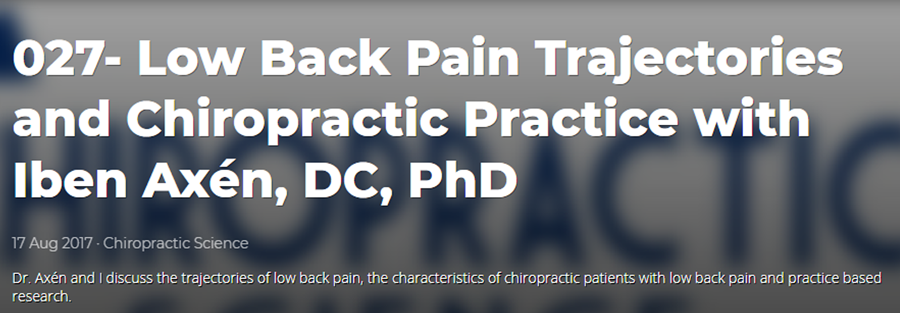An Observational Study on Trajectories and Outcomes of Chronic Low Back Pain Patients Referred From a Spine Surgery Division for Chiropractic Treatment
SOURCE: Chiropractic & Manual Therapies 2019 (Feb 5); 27: 6
Brigitte Wirth, Fabienne Riner, Cynthia Peterson, Barry Kim Humphreys, Mazda Farshad, Susanne Becker and
Petra Schweinhardt
1Integrative Spinal Research Group,
Department of Chiropractic Medicine,
Balgrist University Hospital,
Forchstr. 340, 8008 Zurich, Switzerland
Background: A close collaboration between surgeons and non-surgical spine experts is crucial for optimal care of low back pain (LBP) patients. The affiliation of a chiropractic teaching clinic to a university hospital with a large
spine division in Zurich, Switzerland, enables such collaboration. The aim of this study was to describe the trajectories and outcomes of patients with chronic LBP referred from the spine surgery division to the chiropractic teaching clinic.
Methods: The patients filled in an 11-point numeric rating scale (NRS) for pain intensity and the Bournemouth Questionnaire (BQ) (bio-psycho-social measure) at baseline and after 1 week, 1, 3, 6 and 12 months. Additionally, the Patient’s Global Impression of Change (PGIC) scale was recorded at all time points apart from baseline. The courses of NRS and BQ were analyzed using linear mixed model analysis and repeated measures ANOVA. The proportion of patients reporting clinically relevant overall improvement (PGIC) was calculated and the underlying factors were determined using logistic regression analyses.
Results: Between June 2014 and October 2016, 67 participants (31 male, mean age = 46.8 ± 17.6 years) were recruited, of whom 46 had suffered from LBP for > 1 year, the rest for > 3 months, but < 1 year. At baseline, mean NRS was 5.43 (SD 2.37) and mean BQ was 39.80 (SD 15.16) points. NRS significantly decreased [F(5, 106.77) = 3.15, p = 0.011] to 4.05 (SD 2.88) after 12 months. A significant reduction was not observed before 6 months after treatment start (p = 0.04). BQ significantly diminished [F(5, 106.47) = 6.55, p < 0.001] to 29.00 (SD 17.96) after 12 months and showed a significant reduction within the first month (p < 0.01). The proportion of patients reporting overall improvement significantly increased from 23% after 1 week to 47% after 1 month (p = 0.004), when it stabilized [56% after 3 and 6 months, 44% after 12 months]. Reduction in bio-psycho-social impairment (BQ) was of higher importance for overall improvement than pain reduction.
There are more articles like this @ our:
Conclusions: Chiropractic treatment is a valuable conservative treatment modality associated with clinically relevant improvement in approximately half of patients with chronic LBP. These findings provide an example of the importance of interdisciplinary collaboration in the treatment of chronic back pain patients.
Keywords: Chiropractic, Low back pain, Outcome, Surgery
From the FULL TEXT Article:
Background
Low back pain (LBP) is globally the leading cause for years lived with disability. [1] The point prevalence and 1-month prevalence are estimated to be around 12 and 23%, respectively. [2] The majority of cases have low levels of disability, but combined with the minority of highly disabled LBP-patients, LBP causes high societal and economic burden [3], comparable to cardio-vascular disease in high-income countries. [4] Less than 20% of the LBP patients seen by a surgeon typically need a surgical solution [5], but the challenge is the reliable identification of surgical indications. [6] Thus, close collaboration between spine surgeons and non-surgical spine experts, such as chiropractors, is crucial.
In some countries where chiropractic belongs to complementary and alternative medicine [7-9], some skepticism exists towards chiropractors, e.g. by orthopedic surgeons in North America [10] or general practitioners in Australia. [11] In Switzerland, good inter-professional collaboration between chiropractors and other medical specialists has already been reported in the Swiss job analysis survey in 2009. [12] Additionally, chiropractic medicine is included as one of the five academic medical disciplines in Switzerland (medicine, dentistry, veterinary medicine, pharmacology, chiropractic medicine) and the chiropractic program is part of the Faculty of Medicine at the University of Zurich. [12] The chiropractic students complete a bachelor of medicine degree, in parallel to chiropractic specialty courses, before they enter the chiropractic master program. During the master program, the chiropractic students complete a 6months professional internship in a teaching clinic that is affiliated to a mainly orthopedic university hospital with a large spine division, which offers the unique opportunity for spine surgeons to refer patients directly to the chiropractor, if conservative treatment is deemed to be appropriate.
The aim of this analysis was to study the trajectories and outcomes of patients with chronic low back pain (LBP) referred from the spine division to the chiropractic teaching clinic over the course of 12 months after start of chiropractic treatment.
Read the rest of this Full Text article now!




Leave A Comment